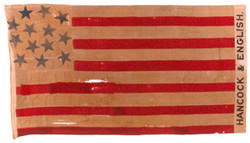

Book Photo
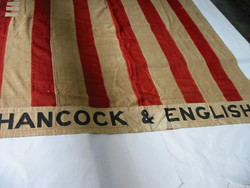
Vertical Stripes
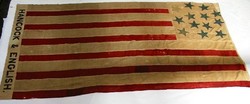
Reverse - edit

info - edit
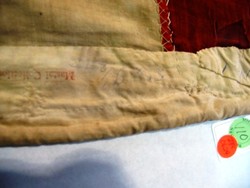
info - edit 3
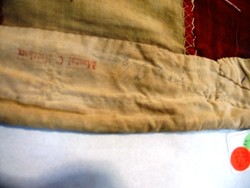
info - edit 4
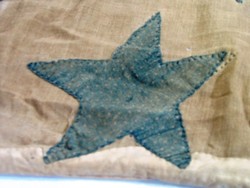
Star Detail - edit 3

Vertical flag - edit 2
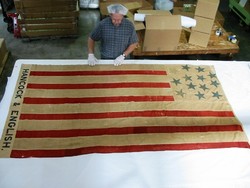
Reverse - edit 3
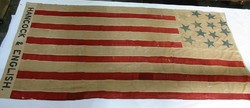
Reverse - edit 2
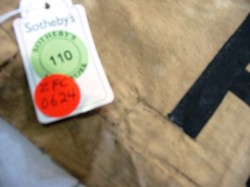
info - edit 2
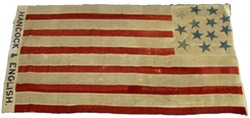
Reverse - edit 1
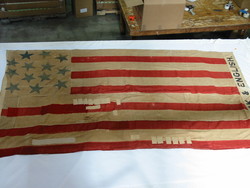
Horizontal Flag

Vertical Flag
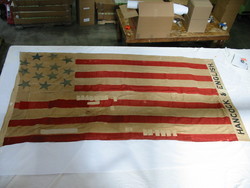
Horizontal Flag

Horizontal Flag

Stars blue
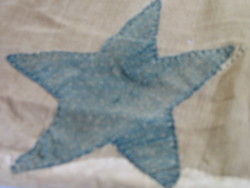
Star Blue

Canton
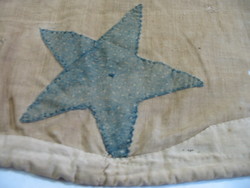
Star blue

info.
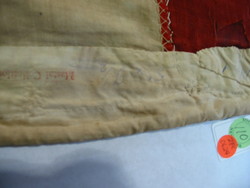
info.
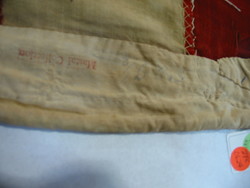
info.

Star Blue

Stripes

Reverse Flag
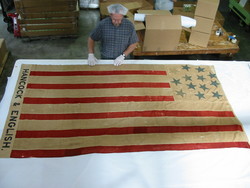
Reverse Flag
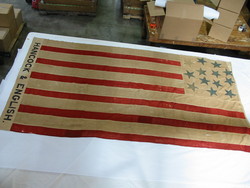
Reverse Flag
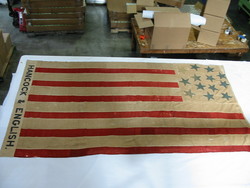
Reverse Flag

Reverse Flag

Reverse Flag
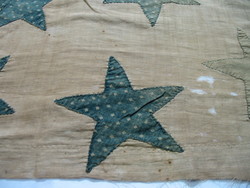
Star

Reverse Flag
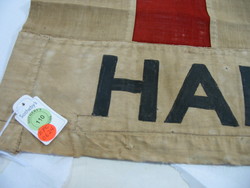
info.

Canton
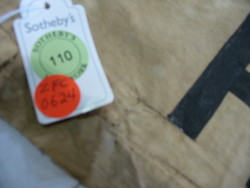
info.
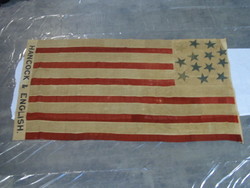
OBVERSE 1
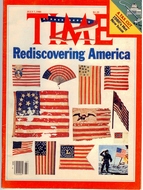
Time Cover
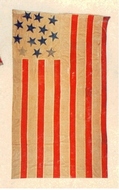
Time Cover Image
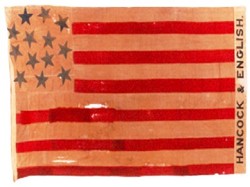
Book Photo - edit
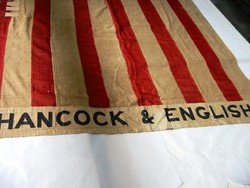
Detail - Edit
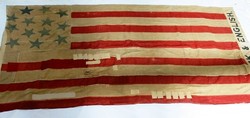
Horizontal- flag edit

Vertical flag - edit
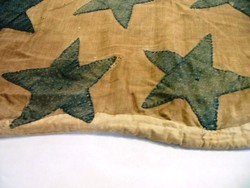
Star Detail - edit
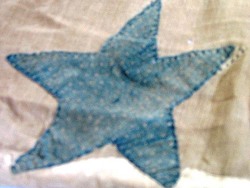
Star Detail - edit

Star Detail - edit
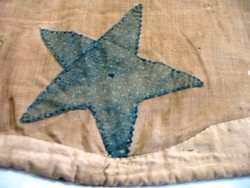
Star Detail - edit 2
U.S. 13 Star Flag - Hancock & English.
Sub-collection: Mastai - Early American Flags13 Star U.S. Flag, Revolutionary & Early Federal Period.
SEE SUMMARY BELOW FOR ORAL DESCRIPTION OF MATERIALS AND TECHNIQUE FOR IDENTIFICATION.
This period thirteen star flag from Salem, MA early history is unknown; but it was formerly part of the acclaimed collection of noted antique dealer Mr. Boleslaw Mastai and his wife Marie-Louise d'Otrange Mastai, formerly of New York City, and later Amagansett, Long Island. Their collection was the result of fifty years of collecting, research and study by the late husband-wife team. Mastai, started collecting in the mid 20th century and amassed to greatest private flag collection in the United States; which he detailed in his ground breaking book The Stars and The Stripes; The American Flag from Birth of the Republic to the Present, published by Alfred Knopf, New York 1973, and was hailed as a revelation of the American Flag as art and as social history.
This is a very rare period 13 star flag. Mastai was very deliberate scholar, and selected this flag as Mastai #1 in his collection, reinforcing the high opinion he had of this flag. Also, it was this flag that he and his wife chose to be photographed holding for the end paper of the book jacket of the aforementioned book. Further, he selected this flag to be featured on the 7 July, 1980 cover of Time magazine after exhibiting it at least twice: : in 1973 at the Amon Carter Museum in Fort Worth Texas, and in 1978 at Building 6, World Trade Center, New York City.
Period illustrations from the 1780s indicate that the 13 stars of the United States flag were occasionally arranged as a circle of 13 or less stars arranged around the remaining stars. And, while this suggests that circular patterns were in the public mind in the 18th century actual flags are quite rare. Similarly, other images indicate that there was little uniformity in the construction and use of early flags; this has given rise to many various interpretations to explain these differences. One common assumption is that militia troops generally carried non standard or variant flags with blue or red stars and stripes of various colors. This seems to stem chiefly from the oral history asserting that North Carolina militia at the Battle of Guilford Courthouse displayed a surviving flag with 13 blue stars on March 15, 1781.
However, what is not in dispute is that two of the design motifs of this flag seem to place it both in New England and the early Federal period: the use of blue stars on a white canton is a design feature on early American Flags that can be definitively dated to the 1790s, and the single ring of nine stars with four center stars the number nine being an auspicious number in the late 18th century.
This star pattern, the single ring of nine with four center stars, is identical to the canton on the flag of the Bucks of America. A Massachusetts militia unit composed of freemen of color who were presented this flag in the late1780s. While circumstantial, it supports the use of this motif during the revolutionary era; a 13 star design literally unknown at any other time in American history. The number nine was an auspicious number in this era because nine represented the number of colonies that attended the Stamp Act Congress and were symbolic of 45 the pamphlet published in 1763 by the civil-rights activist John Wilkes, whose influence on the American revolutionary movement was second only to Tom Paine's Common Sense.
Later, the symbolism of 9 came to represent to the nine states needed to approve the Constitution on September 17, 1787; although Benjamin Franklin had urged unanimity, decided they only needed nine states to ratify the constitution for it to go into effect. Once the Congress of the Confederation received word of New Hampshire's ratification, on June 21, 1788, it set a timetable for the start of operations under the Constitution, and on March 4, 1789, the government under the Constitution began operations; and so 9 came to also represent the nine states which ratified it into existence.
The use of the single ring of nine stars is a symbolic design element that would have been immediately understood the late Colonial, Revolutionary and early Federal Period. Considering the flag from its construction elements and discounting 19th & 20th century repairs and additions, the original portions of this flag contain nothing that would exclude it from being a product of the 18th century. The presence of cotton thread is not a disqualification as recent scholarship has demonstrated the use of cotton in the 1760s and the fabrication of cotton sewing thread in New England as early as 1792. The numerous repairs and remakes also attest to the importance placed upon this flag by subsequent owners.
"One of the oldest 13 star flags in existence reflects the chaos surrounding the creation of the United States flag. In the absence of official guidelines many early flag makers both interpreted and modified the early versions of the American flag. This unique variant of the Stars and Stripes is perhaps the best evidence we have of the peoples flag, demonstrating that our flag was a product of the popular and expedient imagination rather than official writ.
This striking flag, now called the Hancock English Flag, because of the an 1880 presidential election campaign panel added to the fly edge, is a period 13 star flag. One of the few in existence, homemade flags like this one were the norm between 1777 and 1795, when this star count was current. While ships chandlers routinely made flags for maritime and naval use; local governments, the militia and private citizens were left to their own enterprises when a flag was desired.
This flag is constructed out of a variety of fabrics: red wool bunting, white cotton cloth and printed calico blue stars in a very uncommon reversal of the traditional American motifs. There are more white stripes and the star field is the reverse of the normal white stars on blue. Yet it still captures the essence of the Stars and Stripes. Adding to the distinctiveness of the flag is the unusual stat pattern a circle of nine with four stars on the center. The flag was probably made out of the material the seamstress had at hand.
A previous owner of the flag identified it as treasured family relic from New England. Perhaps it was, for at some point the flag was lovingly repaired by removing the bottom white stripe in order acquire fabric to mend and patch this relic of the Early Federal period. Later, demonstrating their support for the Democrat ticket, the fly panel that gives the flag its current name was added recycling this 13 star flag in the 1880s.
Thirteen star flags are quite rare and we are fortunate to have had this historic flag be preserved and conserved by the family that passed it down to us today."
Flag Examination Videos:
Summary - ZFC0624 Flag Examination by Dr. Rabbit Goody, PhD, of Thistle Hill Weavers, May 2009 (4 mins.) Also features summary for ZFC2407 U.S. Revenue-Marine Ensign & Custom House Flag (4 mins.)
Full Flag Examination - ZFC0624 by Dr. Rabbit Goody, PhD, of Thistle Hill Weavers, May 2009 (31 mins.)
Notes:
13 Star, 12-Stripe U.S. Flag. Acquired from Sotheby's Auction in New York City on October 10, 2002. Mastai Lot No. 110. No. 1 in the Mastai collection as indicated on the hoist. Hancock & English painted black on white 108"X59".
The Hancock and English strip on the fly of this flag is an addition sewn on in the 1880 presidential election in which General Hannock of civil war fame was the losing democratic candidate. The Mastai's indicated that this was a flag only brought out by the original family for very special occasions.
Except for the campaign fly, the entire flag is hand sewn, and dates earlier than the fly attachment. The stars are made with calico material representing four different patterns. There are 12 stripes beginning with a white stripe. The canton is white possible linen, which needs confirmation. In addition the star pattern with it's 9/4 set of stars may indicate an early date of construction. The red stripes are made of wool or wool bunting and the white stripes may be linen including the canton. Stars are appliqued on both sides of the canton. Circa 1790's - 1815. Modified for the 1880 Presidential Election.
Exhibition History:
Amon Carter Museum, Fort Worth, Texas
The Stripes and Stars: The Evolution of the American Flag
18 October - 28 July 1973
"Revolutionary Blue Stars Flag"
The US Customhouse Plaza
World trade Center, New York, New York. Gallery
Exhibited as #222 in "Our Unknown Flag" 14 June, 1978 to 28 July 1978"
"The Blue Stars Flag. Revolutionary, Circa 1780-1790 (Hand Lettered Band Added For Presidential Campaign Of 1880) 13 Stars, 12 Stripes. Cotton (Calico) And (Wool) Serge"
Presidential Debate
Washington University at St. Louis
October 2004
Private Showing:
Night of Flags
In celebration of George Washington's Birthday
The National Society of The Colonial Dames of America in California Patriotic Services Committee
James Ferrigan, Curator, Flag Center
Ben Zaricor, Director, Flag Center
Thursday, February 26, 2009
Octagon House, San Francisco
5:30pm to 7:30 pm
Publication History:
Diffily, John A., Number 2, Volume II, Oct. 18-Nov.25, Flag Issue, Newsletter from the Education Department, Amon Carter Museum, Ft. Worth, 1973.
Mastai, Boleslaw and Marie-Louise D'Otrange, The Stars and The Stripes: The American Flag as Art and as History from the Birth of the republic to the Present, Knopf, New York, 1973. pp. 38 & Rear inside flap of jacket.
Mastai, Boleslaw and Marie-Louise D'Otrange, Our Unknown Flag: Almost 250 Flags and Artifacts from the famous Mastai Collection, New York, Boleslaw Mastai, Amagansett, Exhibited 14 June -28 July 1978 US Custom house, Plaza Lever, 6 World trade Center.
Time Magazine, Volume 116, No.1,7 July 1980, Front Cover.
Madaus, Howard M., Dr, Whitney Smith, The American Flag: Two Centuries of Concord and Conflict. Santa Cruz: VZ Publications, 2006, pp. 12-13.
Schrambling, Regina, "A Lifelong Pledge." Collection, Published by Robb Report, June 2014, p. 51.
Provenance:
• Originally from Salem, MA, 1780s.
• Acquired by Mr. & Mrs. Boleslaw & Marie-Louise d'Otrange Mastai, New York City, and Amagansett, NY, The Mastai Collection, until 2002.
• Sold via Sotheby's Auction in New York City to the Zaricor Flag Collection, 2002.
Sources:
Madaus, Howard M.- Whitney Smith, The American Flag: Two Centuries of Concord and Conflict, VZ Publications, Santa Cruz, 2006.
Mastai, Boleslaw and Marie-Louise D'Otrange, The Stars and The Stripes: The American Flag as Art and as History from the Birth of the republic to the Present, Knopf, New York, 1973
Mastai, Boleslaw and Marie-Louise D'Otrange, The Stripes and Stars: The Evolution of the American Flag, Amon Carter Museum, Ft. Worth, 1973.
Mastai, Boleslaw and Marie-Louise D'Otrange, Our Unknown Flag: Almost 250 Flags and Artifacts from the famous Mastai Collection, New York, Boleslaw Mastai, Amagansett, Exhibited 14 June -28 July 1978 US Custom house, Plaza Lever, 6 World trade Center.
Goody, Rabbit, ZFC0624 Analysis Notes, examination and research for Ben Zaricor, April 2009, Zaricor Flag Collection Archives
Diffily, John A., Number 2, Volume II, Oct. 18-Nov.25, Flag Issue, Newsletter from the Education Department, Amon Carter Museum, Ft. Worth, 1973.
Bucks of America Flag (U.S.), Flags of the World, 25 October 2011, from:
http://www.crwflags.com/fotw/flags/us-ma%5Ebk.html
Revolutionary Participation, African Americans and the End of slavery in Massachusetts, Massachusetts Historical Society, 25 October 2011, from: http://www.masshist.org/endofslavery/?queryID=56
The North Briton, Wikipedia, 25 October 2011, from: http://en.wikipedia.org/wiki/The_North_Briton
John Wilkes, Wikipedia, 25 October 2011, from: http://en.wikipedia.org/wiki/John_Wilkes
Image Credits:
Zaricor Flag Collection
Boleslaw Mastai
Image of 13 Star Flag, Time Magazine, Volume 116, No.1, Cover.
Hoist & Fly | |
|---|---|
| Width of Hoist | 60 |
| Length of Fly | 103 |
Union/Canton | |
|---|---|
| Width of Union/Canton | 30 |
| Length of Union/Canton | 26 |
Stars | |
|---|---|
| Comments on Star Measurements | Blue resist dyed cotton with white pattern. 9 Stars in a circle, 4 in the center. Sewn both sides different. There are at least three distinct patterns of resist dyed (calico?) cloth. |
| Size of Stars | 6.5 |
Stripes | |
|---|---|
| Width of 1st Stripe | 5.375 |
| Width of 3rd Stripe | 5.375 |
| Width of 8th Stripe | 4.5 |
| Width of Last Stripe | 3.5 |
| Size of Hoist | 2.5 |
Frame | |
|---|---|
| Is it framed? | no |
Stars | |
|---|---|
| Number of Stars | 13 |
| How are the stars embeded? | Double Applique |
| Are there stars on obverse? | yes |
| Are there stars on reverse? | yes |
| Comments on Stars | Blue resist dyed cotton with white pattern. 9 Stars in a circle, 4 in the center. Sewn both sides different. |
| Star Pattern | Single ring of nine with four center stars. |
Stripes | |
|---|---|
| Number of Stripes | 12 |
| Color of Top Stripe | White |
| Color of Bottom Stripe | Red |
| Has a Blood Stripe? | no |
| Comments on Stripes | There were originally 13 stripes; but the bottom white stripe was cannibalized to repair the flag. |
Crest/Emblem | |
|---|---|
| Description of Crest/Emblem | Stars are in a distinctive single ring of 9 with 4 center stars. |
Nationality | |
|---|---|
| Nation Represented | United States |
Fabric | |
|---|---|
| Fabric | Wool-cotton |
| Comments on Fabric | Stars are blue cotton Calico; red stripes are wool; canton & stripes are unknown white fabric, either cotton or linen. |
Stitching | |
|---|---|
| Stitching | Hand |
Thread | |
|---|---|
| Type of Thread | 3/2 Ply Z |
| Thread Material | Combination |
| Comments on Thread Material | Multiple Thread Z Twist Period 13 Star Flag. Hoist Cloth: Cotton replacement hoist Star Cloth: Cotton resist dyed (calico?) Stripe Cloth: Single ply Cotton & single ply worsted Hand spun & hand woven Canton Cloth: Single ply cotton Hand woven Star Thread: 3 Ply Cotton (blue) Canton Thread: 2 Ply Linen, 2 ply cotton Stripe Thread: 2 & 3Ply cotton, 3/ 2 ply cotton remake with machine sewn repairs Fly Thread: Cotton machine sewn replacement panel< |
| Field Thread | Hand Spun |
Weave | |
|---|---|
| Type of Weave | Plain |
Attachment | |
|---|---|
| Comments on Method of Attachmen | Roped header with loops cut off. Rope through header Hoist Thread: Cotton machine sewn replacement |
| Method of Attachment | Roped-header |
Applica | |
|---|---|
| Applique Sides | Double Faced = Reads correctly on both sides |
Documentation | |
|---|---|
| Documents | |
| Drawings | |
| Research Documents | |
| Public Copy & Signs | |
| Press | |
Condition | |
|---|---|
| Condition | Fair |
| Damage | Used, faded, repaired, stained, and disintegrating on stained points. Trending to good |
| Displayable | yes |
Date | |
|---|---|
| Date | 1790's |
Exhibits | |
|---|---|
| Exhibition Copy | Exhibited as #222 in "Our Unknown Flag" 14 June, 1978 to 28 July 1978" at the US Customhouse, Plaza Level, 6 World trade Center, New York, New York.Gallery Copy, "THE BLUE STARS FLAG. REVOLUTIONARY, CIRCA 1780-1790 (HAND LETTERED BAND ADDED FOR PRESIDENTIAL CAMPAIGN OF 1880)13 STARS, 12 STRIPES. COTTON (CALICO) AND (WOOL) SERGE" Presidential Debate - Washington University at St. Louis October, 2004 (ZFC0624) 13-Star, 12-Stripe United States Flag Early 19th Century; Modified for the 1880 Presidential Campaign This flag is believed to be one of the oldest surviving 13-star flags from the early period of American history. The placement of blue stars on a white canton, a motif that dates from the 1790s, is extremely rare. The flag was modified with the names of the Democrat candidates during the 1880 presidential campaign. Winfield S. Hancock was the famous Union General, commanding the Army of the Potomac's II Corps, who repulsed Pickett's Charge on the third day of the Battle of Gettysburg in 1863. He and his running mate, William H. English, were defeated by Republican candidate and Civil War veteran James A. Garfield in one of the closest elections in American history. Exhibition History - Private Showing Night of Flags In celebration of George Washington's Birthday The National Society of The Colonial Dames of America in California Patriotic Services Committee Presents James Ferrigan, Curator, Flag Center Ben Zaricor, Director, Flag Center Thursday, February 26, 2009 Octagon House, San Francisco 5:30 pm - 7:30 pm This was a power point slide presentation on the period 13 star flag and Presidential flags in the Flag Center/Zaricor Flag Collection and comments by Ben Zaricor wherein the image of this flag was displayed. PBS Text 13 Star US Flag - "Hancock English Flag" Blue stars on an American Flag? More white than red stripes? Recycling old flags? "One of the oldest 13 star flags in existence reflects the chaos surrounding the creation of the United States flag. In the absence of official guidelines many early flag makers both interpreted and modified the early versions of the American flag. This unique variant of the Stars and Stripes is perhaps the best evidence we have of the "peoples flag", demonstrating that our flag was a product of the popular and expedient imagination rather than official writ. This striking flag, now called the "Hancock English Flag", because of the an 1880 presidential election campaign panel added to the fly edge, is a period 13 star flag. One of the few in existence, homemade flags like this one were the norm between 1777 and 1795, when this star count was current. While ships chandlers routinely made flags for maritime and naval use; local governments, the militia and private citizens were left to their own enterprises when a flag was desired. This flag is constructed out of a variety of fabrics: red wool bunting, white cotton cloth and printed calico blue stars in a very uncommon reversal of the traditional American motifs. There are more white stripes and the star field is the reverse of the normal white stars on blue. Yet it still captures the essence of the Stars and Stripes. Adding to the distinctiveness of the flag is the unusual stat pattern - a circle of nine with four stars on the center. The flag was probably made out of the material the seamstress had at hand. A previous owner of the flag identified it as treasured family relic from New England. Perhaps it was, for at some point the flag was lovingly repaired by removing the bottom white stripe in order acquire fabric to mend and patch this relic of the Early Federal period. Later, demonstrating their support for the Democrat ticket, the fly panel that gives the flag its current name was added - recycling this 13 star flag in the 1880's. Thirteen star flags are quite rare and we are fortunate to have had this historic flag be preserved and conserved by the family that passed it down to us today." |
| Exhibition Images | |
Publications | |
|---|---|
| Publication Copy | Publication History: Madaus, Howard M., Dr, Whitney Smith, The American Flag: Two Centuries of Concord and Conflict. Santa Cruz: VZ Publications, 2006, pp. 12-13. "This star pattern, the single ring of nine with four center stars, is identical to the canton on the flag of the Bucks of America. A Massachusetts militia unit composed of freemen of color who were presented this flag in the late 1780s. While circumstantial, it supports the use of this motif during the revolutionary era; a 13 star design literally unknown at any other time in American history. The number nine was an auspicious number in this era because nine represented the number of colonies that attended the Stamp Act Congress and were symbolic of 45 the pamphlet published in 1763 by the civil-rights activist John Wilkes, whose influence on the American revolutionary movement was second only to Tom Paine's Common Sense. Later, the symbolism of 9 came to represent to the nine states needed to approve the Constitution on September 17, 1787; although Benjamin Franklin had urged unanimity, decided they only needed nine states to ratify the constitution for it to go into effect. Once the Congress of the Confederation received word of New Hampshire's ratification, on June 21, 1788, it set a timetable for the start of operations under the Constitution, and on March 4, 1789, the government under the Constitution began operations; and so 9 came to also represent the nine states which ratified it into existence. The use of the single ring of nine stars is a symbolic design element that would have been immediately understood the late Colonial, Revolutionary and early Federal Period. Considering the flag from its construction elements and discounting 19th & 20th century repairs and additions, the original portions of this flag contain nothing that would exclude it from being a product of the 18th century. The presence of cotton thread is not a disqualification as recent scholarship has demonstrated the use of cotton in the 1760s and the fabrication of cotton sewing thread in New England as early as 1792. The numerous repairs and remakes also attest to the importance placed upon this flag by subsequent owners. " Druckman, Nancy, Jeffery Kohn, The American Flag: Designs for a Young Nation, New York, Abrams, 2003.P.71. |
| Flag Books | |










































































